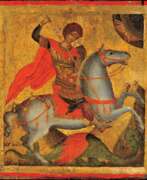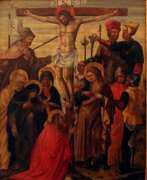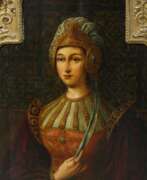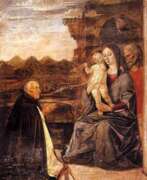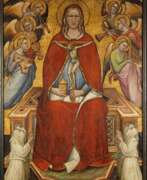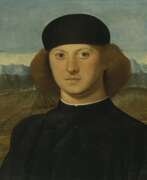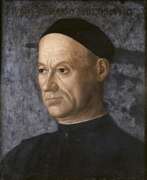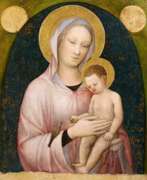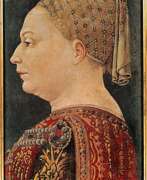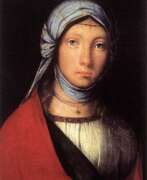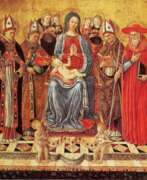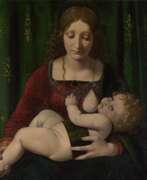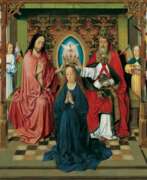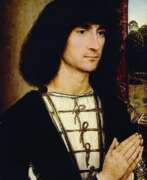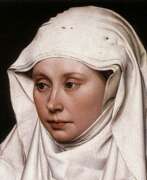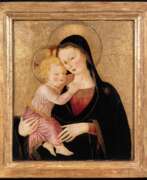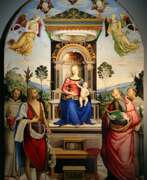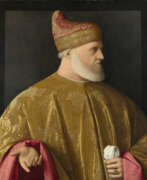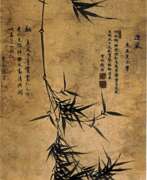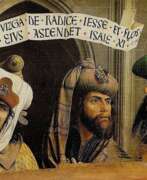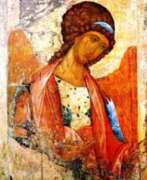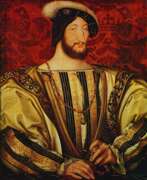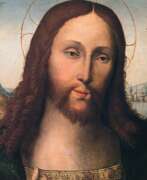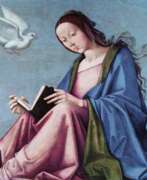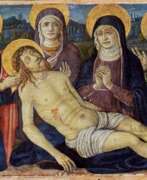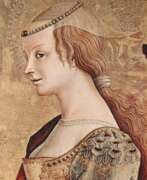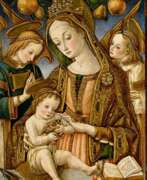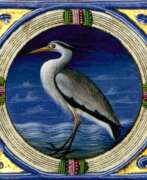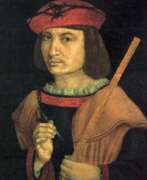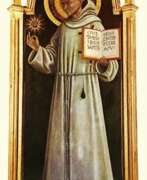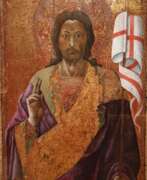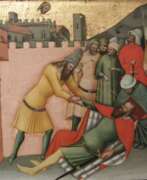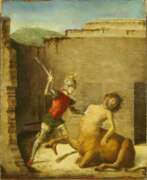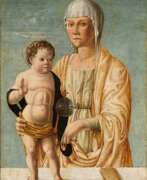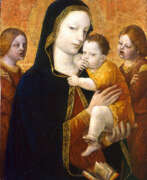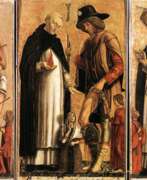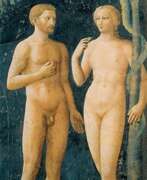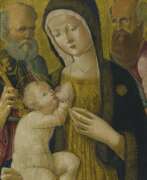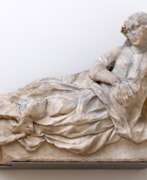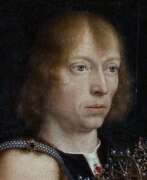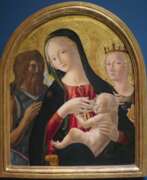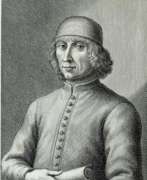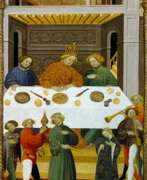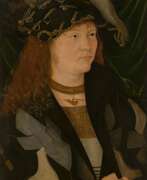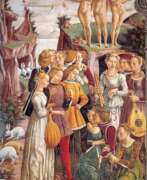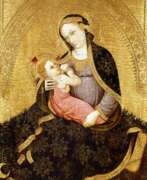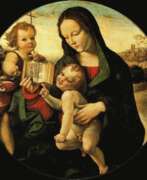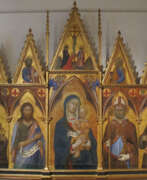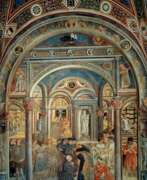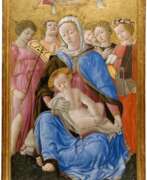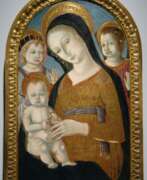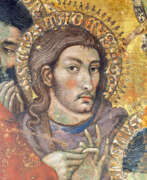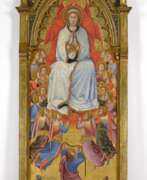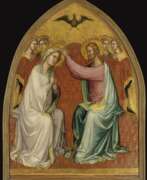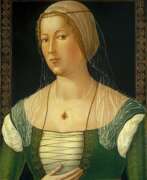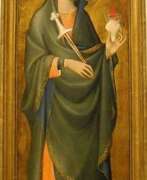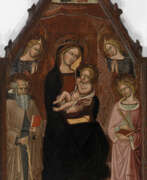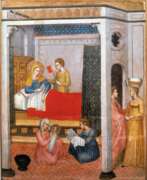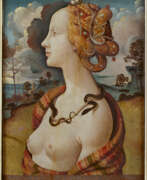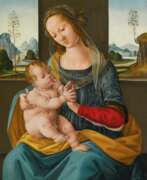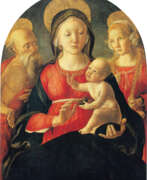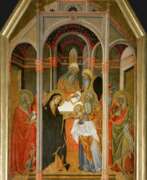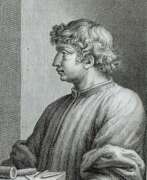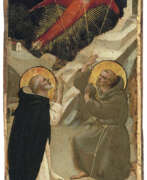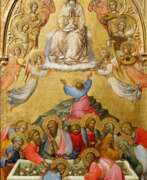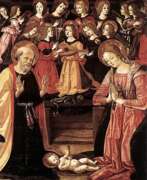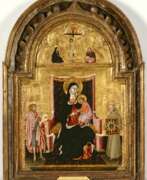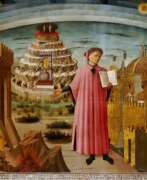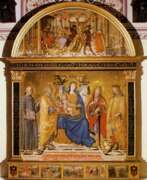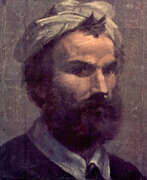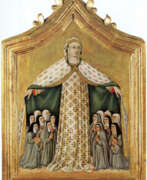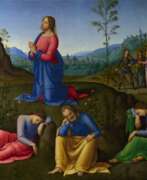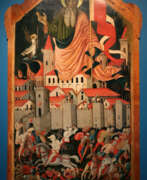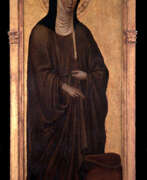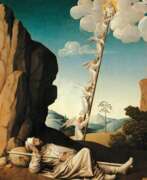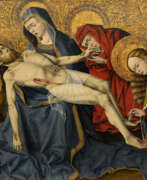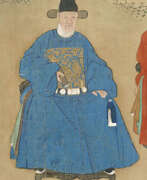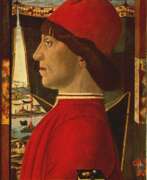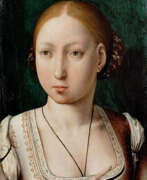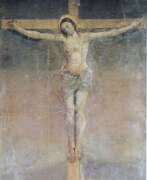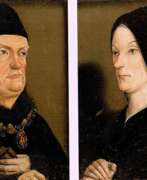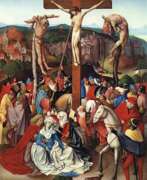Painters 15th century
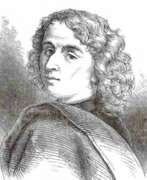

Mariotto Albertinelli, an Italian painter born in 1474, was a prominent figure in the High Renaissance, celebrated for his contribution to the Florentine school of painting. Albertinelli's work is distinguished by its adherence to the principles of the Renaissance, characterized by a profound appreciation for classical beauty, balanced compositions, and a deep engagement with religious themes.
Known for his collaboration with Fra Bartolommeo, Albertinelli's artistry was marked by a harmonious blend of spirituality and naturalism. His paintings are revered for their delicate handling of religious subjects, brought to life with vivid realism and emotional depth. This unique approach made him a pivotal figure in the evolution of Renaissance art, bridging the gap between the divine and the human.
Among his renowned works, the "Visitation of the Virgin Mary" stands out as a masterpiece, showcasing his skillful use of color and perspective to enhance the narrative. Albertinelli's contributions can be found in several prestigious museums and collections around the world, offering a testament to his enduring legacy.
For collectors and connoisseurs of art and antiques, Mariotto Albertinelli represents the quintessence of Renaissance artistry. His works not only capture the aesthetic ideals of his time but also reflect the cultural and spiritual aspirations of the era.
To delve deeper into the life and art of Mariotto Albertinelli and stay informed about upcoming exhibitions, sales, and auctions featuring his work, signing up for updates is essential. This subscription ensures that enthusiasts and collectors alike remain connected to the vibrant legacy of this Renaissance master, offering exclusive insights and opportunities to enhance their appreciation and collection.
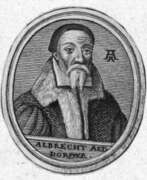

Albrecht Altdorfer, a notable German painter, engraver, and architect of the Renaissance era, was especially recognized for his contributions to landscape painting. Born around 1480, Altdorfer was a pivotal figure in the Danube School, distinguishing himself with his integration of natural landscapes into biblical and historical narratives.
His works are celebrated for their detailed and expressive landscapes, often serving as backdrops to religious and historical scenes. A hallmark of his style is the emotional intensity and vivid use of colors, which border on expressionistic in his religious scenes, particularly seen in works like the Sebastian Altar in St. Florian's Priory. Altdorfer's painting, "The Battle of Alexander at Issus," stands out for its epic portrayal of Alexander the Great's victory, showcasing Altdorfer's talent in blending historical narrative with dramatic landscape settings.
In addition to his artistic pursuits, Altdorfer was actively involved in the civic life of Regensburg, serving as its mayor in 1528. His legacy in the art world is profound, with his innovative approach to landscape painting influencing the course of European art.
For those interested in delving deeper into Albrecht Altdorfer's oeuvre or staying informed about related exhibitions and auction events, signing up for updates can provide valuable insights and opportunities.
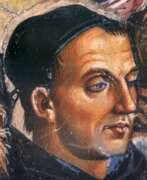

Fra Angelico, a name synonymous with the serenity and purity of Early Renaissance art, was a Dominican friar and Italian painter celebrated for his devout and luminous religious works. Born Guido di Pietro around 1395 in Vicchio, near Florence, he later became known as Fra Giovanni upon joining the Dominican order at Fiesole. His monastic life profoundly influenced his art, reflecting a deep spiritual commitment and a heavenly tranquility. Pope John Paul II recognized his sanctity by beatifying him in 1982, officially bestowing upon him the title "Blessed" and affirming his legacy as a bridge between heaven and earth through his art.
Fra Angelico's technical prowess and innovative approaches to composition and color set new standards in the art world. He was initially trained as an illuminator, which is evident in the delicate details and luminous quality of his works. His art was not confined by his religious duties; instead, his position allowed him to advance the Dominican order's mission through visually compelling narratives that spoke directly to the viewer's soul. His works, including altarpieces and frescoes, are revered for their serene religious attitude and classical influence, embodying the Early Renaissance spirit that sought to harmonize Christian themes with the natural world and human emotion.
Among his most notable contributions are the frescoes at the convent of San Marco in Florence, commissioned by Cosimo de' Medici. These works display Angelico's mastery over perspective and his ability to create a spiritual atmosphere that invites contemplation. The Annunciation, one of his most famous frescoes at San Marco, exemplifies his use of architectural space to frame the sacred narrative, integrating the divine with the everyday. His altarpieces, characterized by their detailed figures and harmonious compositions, were innovative in their unified presentation of sacred stories, moving away from the segmented Gothic style towards a more cohesive and immersive narrative experience.
Fra Angelico's influence extended beyond his lifetime, shaping the trajectory of Renaissance art through his integration of humanistic principles with devout Christian faith. His works are preserved in some of the world's most prestigious museums, including the Museo Diocesano in Cortona, the Uffizi Gallery, and the Museo del Convento di San Marco in Florence, continuing to inspire awe and reverence among viewers.
For collectors and experts in art and antiques, the legacy of Fra Angelico offers a window into the soul of the Renaissance, where beauty and spirituality converge. To stay informed about new product sales and auction events related to this pivotal artist, signing up for updates is a prudent step towards enriching one's collection with works that embody the zenith of religious and artistic expression in the Early Renaissance.
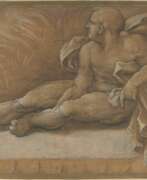

Amico Aspertini was an Italian Renaissance painter, draughtsman, and sculptor, considered one of the leading representatives of the Bolognese school of painting.
He was trained in the family workshop and was influenced by the artists of the Ferrara school, Ercole de'Roberti, Lorenzo Costa, and Francesco Francia. He worked as a painter and sculptor, and was also an excellent draughtsman, as evidenced by his many surviving drawings and sketches. Contemporaries marveled at his complex and impulsive character and noted that he worked with both hands simultaneously.
Aspertini painted splendid portraits as well as numerous frescoes and altarpiece paintings in chapels and churches in Italy. Many of his works are eccentric and eclectic, even whimsically fantastical, his complex style anticipating Mannerism.
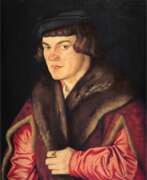

Hans Baldung, also known as Hans Baldung Grien, was a prominent figure in the German Renaissance, celebrated for his innovative approach to painting, printmaking, and drawing. Born around 1484 in Schwäbisch Gmünd, Germany, and passing away in 1545 in Strasbourg, France, Baldung's career was marked by a distinctive style that art historians have associated with the mannerist tendencies of the time. His work is notable for its exploration of themes such as the imminence of death, the complexities of human sexuality, and scenes of witchcraft, distinguishing him from his contemporaries with a bold and unique artistic voice.
Educated in the workshop of Albrecht Dürer, Baldung quickly developed his own artistic language, absorbing and then transcending Dürer's influence. He is particularly renowned for his altarpieces, portraits, and a series of works that delve into eroticism and the supernatural. Among his most significant contributions is the high altar of the Freiburg Münster, an eleven-panel masterpiece depicting scenes from the life of the Virgin Mary, which remains a testament to his mastery over religious subjects even as he ventured into more secular and profane themes.
Baldung's fascination with witchcraft and his portrayal of witches in art were groundbreaking for the time. His works in this area, such as "The Witches' Sabbath" and "Weather Witches," reveal a complex interplay of humanist thought, classical literature, and contemporary beliefs about witchcraft. They offer a nuanced perspective that blends satire with a deeper commentary on human nature and societal fears, marking Baldung as a pioneer in the visual exploration of these themes.
Despite his engagement with the themes of death and witchcraft, Baldung's oeuvre is also rich in portraits characterized by sharp individualization and psychological depth, as well as altarpieces that convey a profound spiritual and theological insight. His ability to navigate between the realms of the divine and the earthly, the solemn and the profane, solidifies his position as a versatile and innovative artist of the Renaissance.
For collectors and experts in art and antiques, Hans Baldung's work offers a unique window into the confluence of Renaissance artistry, humanist thought, and the socio-religious dynamics of early 16th-century Europe. His paintings and prints not only adorn museums and galleries worldwide but also continue to inspire and provoke deep reflection on the human condition.
To stay informed about new discoveries, exhibitions, and auction events related to Hans Baldung's art, signing up for updates can provide enthusiasts and collectors with valuable insights into the enduring legacy of this remarkable artist. This subscription service is designed to alert subscribers to new product sales and auction events specifically related to Hans Baldung, ensuring that they remain at the forefront of developments in the field of Renaissance art and antiques.
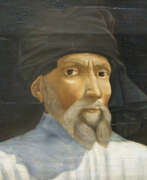

Donato di Niccolò di Betto Bardi, better known as Donatello, sculptor of the Renaissance period. Born in Florence, he studied classical sculpture and used this to develop a complete Renaissance style in sculpture. He spent time in other cities, and while there he worked on commissions and taught others; his periods in Rome, Padua, and Siena introduced to other parts of Italy his techniques, developed in the course of a long and productive career. Financed by Cosimo de' Medici, Donatello's David was the first freestanding nude male sculpture since antiquity.
He worked with stone, bronze, wood, clay, stucco, and wax, and had several assistants, with four perhaps being a typical number. Although his best-known works mostly were statues in the round, he developed a new, very shallow, type of bas-relief for small works, and a good deal of his output was larger architectural reliefs.
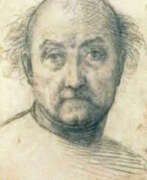

Fra Bartolomeo was an Italian painter, a notable figure of the High Renaissance. Known for his religious artworks, Fra Bartolommeo's style was deeply influenced by his spiritual journey and association with the Dominican Order.
After receiving his early artistic training from Cosimo Rosselli, Bartolommeo's style initially exhibited influences from artists like Piero di Cosimo, Domenico Ghirlandaio, and Filippino Lippi. However, his encounter with Savonarola, a Dominican friar and reformer, in the late 1490s led to a significant spiritual transformation. This encounter influenced him to enter the Dominican monastery at San Domenico in Prato as a novice in 1500, and he temporarily renounced painting. It wasn't until 1504, when he resumed painting as the head of the monastery workshop, that his style saw a significant transformation.
In his works, Fra Bartolomeo beautifully integrated the styles of Leonardo da Vinci and Raphael, especially in his altarpieces, which are imbued with a sense of pietism reminiscent of Fra Angelico. His work is notable for the skilled massing of light and shade, richness in coloring, and delicate handling of drapery. The introduction and use of the lay-figure with joints in his compositions were innovations he is credited with. His masterpiece, St. Mark Evangelist, and the undraped figure of Saint Sebastian, are particularly noted for their expressive power.
Some of his notable works include "Vision of St. Bernard" (1507), "The Holy Family with John the Baptist," and "Virgin and Child with Saints." His art can be found in prestigious galleries, including the Pinacoteca Vaticana, Palazzo Pitti in Florence, and the National Gallery in London.
For art collectors and enthusiasts, Fra Bartolomeo's works represent a blend of spiritual depth and artistic innovation during the pinnacle of the Renaissance period. His legacy in religious art continues to inspire and captivate audiences worldwide.
To stay informed about exhibitions and sales featuring works of Fra Bartolomeo, sign up for updates to explore more about this master's contributions to Renaissance art.
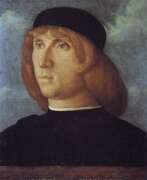

Giovanni Bellini was a renowned Italian painter, celebrated for his pivotal role in the Venetian Renaissance. Born around 1430 in Venice, Italy, Bellini's work is distinguished by its innovative use of color, keen interest in light, and meticulous brushwork, which marked a significant departure from the styles of his predecessors and contemporaries. He is acknowledged as one of the most influential figures of the Bellini family, a lineage of esteemed Venetian painters that profoundly shaped the course of Venetian art.
Bellini's oeuvre spans religious altarpieces, portraits, and mythological scenes, demonstrating a gradual evolution from the narrative-driven compositions of the Early Renaissance to a more nuanced naturalism and emotional depth. Notable works include the "San Zaccaria Altarpiece," celebrated for its serene beauty and imposing presence, and "The Feast of the Gods," a secular piece illustrating Bellini's late career shift towards more naturalistic mythologies and exploration of erotic themes in accordance with the trends of early 16th-century Renaissance art.
His early works, characterized by the use of tempera, exhibit a unique blend of the Paduan school's severity and a profound religious sentimentality, setting the stage for his later mastery of oil painting. This mastery allowed Bellini to achieve unparalleled atmospheric effects and a harmonious blend of colors, contributing significantly to the development of Venetian painting. His contributions were not limited to his own works; Bellini also played a crucial role as a teacher, influencing future generations of artists including Giorgione and Titian, thus ensuring his lasting impact on the Renaissance art movement.
Giovanni Bellini's works are preserved in several prestigious museums and galleries worldwide, serving as a testament to his enduring legacy in the art world. His ability to infuse his paintings with a sense of divine tranquility, coupled with his innovative techniques, has cemented his status as a key figure in the history of Western art.
For collectors and experts in art and antiques, Giovanni Bellini's work represents not only a pinnacle of Renaissance artistry but also a bridge between the medieval and modern worlds. His nuanced approach to color, light, and composition continues to inspire and attract admiration from across the globe.
Stay updated on new discoveries, sales, and auction events related to Giovanni Bellini's work by signing up for our updates. This subscription ensures you're informed about the latest opportunities to engage with the legacy of one of Venice's most illustrious painters.
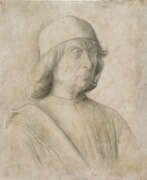

Gentile Bellini was a seminal Venetian painter, born circa 1429 into Venice’s preeminent family of artists. Known primarily for his portraiture and scenes depicting the Middle East, Bellini's style was marked by precise execution and keen attention to detail. His paintings, especially those from his time in Constantinople, showcased an enchanting blend of Western and Eastern artistic elements, contributing significantly to the Orientalist movement in Western art.
His works are renowned for their incorporation of architectural elements from the regions he visited, which played a pivotal role in educating Europeans about cultures beyond their borders. Bellini served as a cultural ambassador to the Ottoman Court, painting the portrait of Sultan Mehmed II, a work that remains notable for its vivid portrayal and historical significance.
Despite the destruction of many of his paintings, some of Bellini's masterpieces continue to be celebrated, such as "The Miracle of the True Cross at the Bridge of San Lorenzo" and "The Procession in Piazza San Marco," which reflect the grandeur and spirit of Venice during the Renaissance.
Bellini's legacy extends beyond his canvases, influencing the craft and direction of future artists, including his student Titian. While contemporary critics often regard his brother, Giovanni Bellini, as the more accomplished artist, Gentile's contributions to the Venetian school and his role in bridging Western and Eastern art remain undisputed.
For collectors and art experts, Gentile Bellini's work represents a confluence of cultural narratives and artistic excellence. To stay informed about exhibitions and sales featuring Gentile Bellini's work, signing up for updates can provide an exclusive edge in the art and antiques sphere.
If you're interested in exploring Gentile Bellini's works further or considering acquisitions for your collection, don't hesitate to sign up for updates on new product sales and auction events related to this pivotal artist. This service promises a business-like and direct approach to keeping you informed without unnecessary flourish.
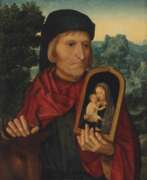

Ambrosius Benson was an Italian painter who became a part of the Northern Renaissance.
While many surviving paintings have been attributed, there is very little known of him from records, and he tended not to sign his work. He is believed to be responsible for mainly religious art, but also painted portraits on commission. He sometime painted from classical sources, often setting the figures in modern-dress, or a contemporary domestic setting. In his lifetime he was successful; he had a large workshop, his work was sold internationally and he was especially popular in Spain.
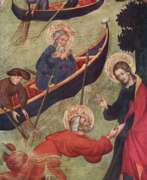

Lluís Borrassà, a prominent Catalan painter, is renowned for revolutionizing the Gothic painting style in Catalonia. Born around 1360 in Girona and possibly deceased in 1426 in Barcelona, Borrassà's contribution to the art world is immeasurable. He was notably employed by the Crown of Aragon, an association that not only enhanced his prestige but also facilitated the spread of his unique artistic style.
Borrassà's art is distinguished by its embodiment of the International Gothic painting style, a movement he is credited with introducing to Catalonia. His works are characterized by their vibrant colors and detailed depictions, elements that were innovative for his time. This distinctive style set a new standard in the region, influencing many subsequent artists and marking a pivotal point in the history of Catalan art.
Among Borrassà's notable works are the panels of the 'Profession of Saint Peter the Martyr' and the 'Beheading of the Relatives of Sant Hipòlit', both of which are now treasured parts of the Gothic art collection at the Museu Nacional d'Art de Catalunya. These artworks not only showcase Borrassà's mastery of color and detail but also provide a window into the cultural and historical context of the period.
For art collectors and experts, Borrassà's work represents a significant chapter in the evolution of European art, particularly within the Gothic tradition. His paintings are not just visual treats but are also rich in historical value, offering insights into the cultural and artistic landscape of 14th and 15th century Catalonia.
To stay updated on sales and auction events related to Lluís Borrassà's works, sign up for our updates. This subscription is specifically tailored for enthusiasts interested in the confluence of art, history, and culture, focusing exclusively on news related to Borrassà's art.
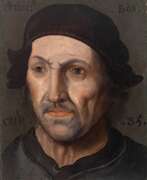

Hieronymus Bosch, a Netherlandish painter born around 1450 in 's-Hertogenbosch, remains one of the art world's most enigmatic figures. Bosch's work is renowned for its intricate, symbolic, and often unsettling imagery, depicting fantastical creatures, earthly pleasures, and human folly with a depth that continues to fascinate scholars and art lovers alike. Despite the scarcity of biographical details—owing to the lack of personal letters or diaries—Bosch's legacy as a pivotal figure in the transition from the medieval to the modern worldview is undisputed.
Bosch spent virtually his entire life in his birthplace, where his family had deep roots in the artistic community. His grandfather and father were both painters, suggesting that Bosch likely received his initial training within his family. By the late 15th century, Bosch had become a respected member of the local Brotherhood of Our Lady, contributing significantly to the cultural and religious life of his community through his artworks. Notably, Bosch's oeuvre includes around thirty paintings, with "The Garden of Earthly Delights," a triptych full of intricate, allegorical imagery, standing out as one of his masterpieces. This work, alongside others such as "The Temptation of St. Anthony" and "The Haywain Triptych," showcases Bosch's unique ability to blend religious themes with his vivid imagination, offering commentary on human sin and redemption.
Bosch's art, characterized by its detailed landscapes populated with a myriad of creatures both heavenly and demonic, reflects a deep moral concern with the fate of humanity, yet leaves much to interpretation. His works are preserved in some of the world's most prestigious museums, including the Museo del Prado in Madrid, where "The Garden of Earthly Delights" is housed, underscoring his lasting impact on the cultural and artistic heritage of the Renaissance period.
Despite the challenges in attributing some works definitively to Bosch due to the absence of signatures on many of his paintings, about 25 paintings and eight drawings are confidently ascribed to him, with others attributed to his workshop. Bosch's influence extended beyond his lifetime, notably inspiring Pieter Bruegel the Elder, and continues to captivate contemporary audiences with his complex iconography and detailed panoramic scenes.
For collectors and experts in art and antiques, Bosch's work represents a fascinating intersection of culture, art, and the human condition, offering endless avenues for exploration and appreciation. To stay updated on new discoveries, sales, and auction events related to Hieronymus Bosch, signing up for updates can provide exclusive insights and opportunities to deepen one's understanding and collection of this remarkable artist's work.
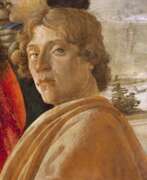

Sandro Botticelli, an Italian painter of the Early Renaissance, was renowned for his exquisite works that beautifully merged classical mythology with religious themes. Born Alessandro di Mariano di Vanni Filipepi in Florence around 1445, Botticelli became a pivotal figure in the Florentine art scene under the patronage of the Medici family. His education under Filippo Lippi honed his skills in painting, leading to a unique style that emphasized linear grace and ethereal beauty. Botticelli's art is celebrated for its elegance and for capturing the spirit of the Renaissance, a period marked by a rebirth of interest in classical antiquity and humanistic values.
Botticelli's oeuvre includes iconic mythological paintings like "The Birth of Venus" and "Primavera," both housed in the Uffizi Gallery in Florence. These masterpieces are distinguished by their allegorical complexity and the delicate portrayal of figures that seem to transcend the earthly realm, reflecting Botticelli's interest in blending myth with a narrative style that appeals to the viewer's sense of wonder and contemplation. His religious works, characterized by expressive emotion and devotional intensity, also earned him acclaim, particularly his contributions to the Sistine Chapel in Rome.
Despite his success, Botticelli's later years were marked by a shift in style influenced by the somber preachings of Savonarola, leading to a preference for more devotional themes. His reputation waned posthumously until the late 19th century, when a resurgence of interest in his work restored Botticelli to his rightful place as a master of the Renaissance. Today, Botticelli is regarded as an artist whose works encapsulate the innovative spirit of his time, bridging the Gothic tradition with the emerging Renaissance aesthetic. His legacy endures, inspiring art lovers and collectors who are drawn to the ethereal beauty and rich symbolism of his paintings.
For those captivated by the allure of Renaissance art, subscribing for updates on new discoveries, sales, and auction events related to Sandro Botticelli can enrich your appreciation and knowledge of this remarkable artist's contribution to the world of art and culture.
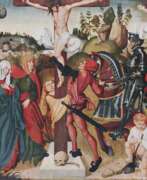

Jörg Breu the Elder of Augsburg, was a painter of the German Danube school. He was the son of a weaver. He journeyed to Austria and created several multi-panel altarpieces there in 1500–02, such as the Melk Abbey altar (1502). He returned to Augsburg in 1502, where he became a master. He travelled to Italy twice, in ca. 1508 and in 1514/15.
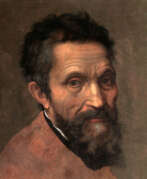

Michelangelo di Lodovico Buonarroti Simoni, known simply as Michelangelo, was an Italian sculptor, painter, architect, and poet who played a significant role in the High Renaissance period. Born on March 6, 1475, in Caprese, Italy, Michelangelo's works are a testament to his mastery in various artistic realms, defining him as a quintessential Renaissance man.
Michelangelo's fame began early in his career, most notably with his sculptures "Pietà" (1499) and "David" (1501), both completed before he turned thirty. Despite his self-perception primarily as a sculptor, Michelangelo made an indelible mark in painting, particularly with the frescoes in the Sistine Chapel. These works include the scenes from Genesis on the chapel's ceiling and "The Last Judgment" on its altar wall, showcasing his innovative use of physical realism and psychological tension.
Among his most famous works, the "David" statue, now housed in the Accademia Gallery in Florence, and the "Pietà," located in St. Peter's Basilica, stand out for their intricate detail and emotional depth. Michelangelo's ability to imbue life into marble and his thoughtful consideration of light and shadow in painting were revolutionary. His techniques in fresco painting, such as the buon fresco method used in the Sistine Chapel, where he painted on wet plaster, were groundbreaking for their time.
Despite his temperamental nature, Michelangelo was deeply religious and dedicated to his art, often eschewing the use of assistants. His works were not only recognized and admired in Italy but also attracted attention from abroad, including the Ottoman Empire. Michelangelo's influence extended beyond his lifetime, significantly impacting the development of Mannerism and the Baroque style.
For art collectors and experts, Michelangelo's works remain a pinnacle of artistic achievement. His ability to blend realism with expressive physicality in both sculpture and painting set new standards in art. His works in major museums and galleries worldwide continue to inspire and awe viewers, reflecting the enduring legacy of his genius.
For those interested in the world of art and antiques, staying informed about Michelangelo's works and their influence on modern art is essential. To receive updates on new product sales and auction events related to Michelangelo, sign up for our newsletter. This subscription is an excellent opportunity for enthusiasts and experts alike to stay connected with the ongoing legacy of one of history's greatest artists.
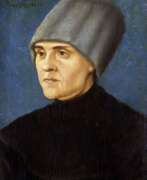

Hans Burgkmair the Elder was a German Renaissance painter, graphic artist and sculptor. He came from a family of painters. He studied painting with Martin Schongauer in Colmar from 1488.
Hans Burgkmayr was a versatile artist, working in various techniques including painting, woodcuts, stained glass designs and tapestries. He was known for his complex and detailed style, which included elements of naturalism and symbolism.
Burgkmayr's paintings often depicted religious and mythological themes, as well as historical events. His style is influenced by the Italian Renaissance, particularly in its attention to anatomical accuracy and use of perspective.
One of Hans Burgkmayr's significant contributions was in the field of engraving. His woodcuts were highly regarded for their technical skill and artistic quality.
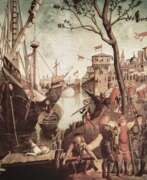

Vittore Carpaccio, an illustrious Italian painter, was a master of narrative storytelling and vivid detail, flourishing in Venice between 1465 and 1526. His specialization in religious and historical scenes set him apart, with a particular knack for infusing life and emotion into every brushstroke. Carpaccio's work exemplifies the Venetian School's richness, noted for its deep colors and intricate details that capture the viewer's imagination.
Carpaccio is renowned for his ability to weave intricate narratives through his paintings, often depicting scenes from the lives of saints with both devotion and a keen eye for daily Venetian life. His works are celebrated for their meticulous attention to architectural and costume details, offering a window into the Renaissance period's social and cultural contexts.
Among his known masterpieces, the cycle of paintings dedicated to the legend of Saint Ursula in the Scuola di San Giorgio degli Schiavoni in Venice stands as a testament to his narrative prowess and technical skill. These works, alongside others housed in prestigious galleries worldwide, underscore Carpaccio's significant contribution to the art world, making him a subject of admiration among collectors and art historians alike.
For those fascinated by the splendor of the Renaissance and the beauty of Venetian artistry, Vittore Carpaccio's oeuvre offers a rich tapestry of historical and religious narratives brought to life through his exceptional talent. His legacy continues to inspire and captivate, embodying the essence of one of the most vibrant periods in art history.
To delve deeper into the world of Vittore Carpaccio and stay informed about upcoming sales, exhibitions, and auction events featuring his work, signing up for updates is your gateway to the exclusive circle of Renaissance art enthusiasts. This subscription is a commitment to keeping you at the forefront of new discoveries and opportunities to enrich your collection with pieces by this Venetian master.
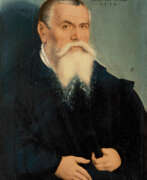

Lucas Cranach the Elder was a pivotal figure in German Renaissance art. As a leading painter of Saxony, his influence spanned across the 16th century, making significant contributions through his paintings, woodcuts, and engravings. His artistic journey began under the tutelage of his father, Hans Maler, and saw him becoming court painter to the Elector of Saxony, where he produced a vast array of works including altarpieces, court portraits, and notably, portraits of Protestant Reformers.
Cranach's artistry was not confined to any single genre. He was renowned for his portraits of the aristocracy, deeply symbolic religious paintings, and engaging mythological scenes. His ability to capture the essence of the Protestant Reformation, notably through his portraits of Martin Luther, showcases his close connection to the movement and his role as a key figure in conveying its ideals through art.
A significant part of Cranach's legacy is his workshop in Wittenberg, which was a hub of artistic production. This workshop produced numerous works that bore his distinctive winged serpent signature, a mark of quality and innovation in the art of the period. Cranach's workshop was known for its efficient operation, enabling the production of a large volume of works that catered to the high demand of his time.
For collectors and experts in art and antiques, Lucas Cranach the Elder's work represents an intriguing intersection of art, culture, and history. His contributions to Renaissance art and his unique portrayal of religious and mythological themes continue to captivate audiences, making his work highly sought after in the world of art collection.
To explore more about Lucas Cranach the Elder's fascinating contributions to art and to stay updated on new discoveries or auction events related to his works, consider signing up for specialized updates. This subscription is designed for enthusiasts keen on delving deeper into the rich tapestry of Renaissance art and history, ensuring they remain well-informed of relevant sales and scholarly insights.
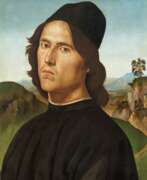

Lorenzo di Credi was an Italian Renaissance painter and sculptor best known for his paintings of religious subjects. He is most famous for having worked in the studio of Andrea del Verrocchio at the same time as the young Leonardo da Vinci.
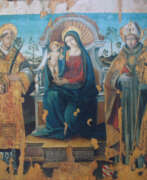

Protasio Crivelli was an Italian painter who worked in Milan during the late fifteenth and early sixteenth centuries.
He studied at the studio of Marco d'Ogiono, a representative of the Lombard Renaissance. Many of his works are in churches in the Neapolitan area.
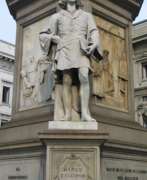

Marco d'Oggiono was an Italian Renaissance painter and a chief pupil of Leonardo da Vinci, many of whose works he copied.
He was a hard-working artist, but his work has since been criticized by some for paintings are wanting in vivacity of feeling and purity of drawing, while, in his composition, it has been well said that "intensity of color does duty for intensity of sentiment". He copied Leonardo's Last Supper repeatedly, and one of his best copies is in the possession of the Royal Academy of Arts.
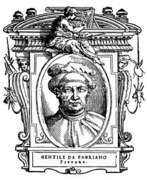

Gentile da Fabriano was an Italian painter known for his participation in the International Gothic painter style. He worked in various places in central Italy, mostly in Tuscany. His best-known works are his Adoration of the Magi from the Strozzi Altarpiece (1423), and the Flight into Egypt. Following a visit to Florence in the 1419, he came in contact with humanism, which influenced his work throughout the rest of his career. He became highly influential for other painters in Florence, especially because of his use of detail based on the observations he made of the natural world.
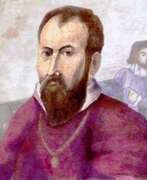

Melozzo da Forlì, an influential Italian Early Renaissance painter and architect, is celebrated for his pioneering work in the realm of fresco painting and his remarkable use of foreshortening, a technique that gives the illusion of depth in a two-dimensional space. Born on June 8, 1438, in Forlì, Italy, Melozzo was a leading figure in the art world of his time, leaving an indelible mark on the Renaissance culture and art landscape.
His tenure in Rome, from around 1472-74, was particularly fruitful, marking a period where he created some of his most notable works. The fresco "Sixtus IV Appointing Platina as Librarian of the Vatican Library," completed in 1477 and now housed in the Pinacoteca Vaticana, stands as a testament to his mastery of perspective and architectural representation. Melozzo's work in the Basilica dei Santi Apostoli in Rome, particularly the fresco depicting the Ascension of Christ, is another significant contribution, showcasing his ability to portray figures with dynamic realism and depth.
Throughout his career, Melozzo also engaged in architectural design and was involved in the construction of Palazzo Altemps for Girolamo Riario in Rome, demonstrating his versatile talent beyond painting. His influence extended to his pupils, notably Marco Palmezzano, and his style and techniques continued to inspire future generations, including Raphael and Michelangelo.
Melozzo's legacy is characterized by his contributions to the development of pictorial art, especially his innovative use of perspective and foreshortening. Although many of his works have been lost or damaged over time, those that survive continue to be studied and admired for their artistic and technical prowess. His final years were spent in his hometown of Forlì, where he died on November 8, 1494, leaving behind a body of work that continues to be celebrated for its influence on the Renaissance art movement.
For collectors and experts in art and antiques, Melozzo da Forlì's work represents a pivotal moment in the history of Renaissance art, embodying the transition towards more dynamic and realistic representations. If you're keen on exploring the contributions of this remarkable artist further, consider signing up for updates related to Melozzo da Forlì. This subscription will keep you informed about new product sales and auction events, offering a unique opportunity to connect with the rich heritage of Renaissance art and culture.
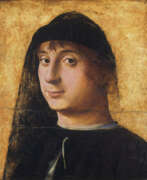

Antonello da Messina, a preeminent Italian painter born around 1430 in Messina, Sicily, left an indelible mark on the art world with his pioneering techniques and emotive works. He is primarily recognized for his profound influence on Venetian painting during the Renaissance, although his reach extended far beyond Venice.
Antonello da Messina's early work, thriving with eclectic influences from Flemish, Catalan, and Provençal elements, reflects the diverse artistic culture of southern Italy. His journey took a significant turn with his move to Venice around 1475, where he not only embraced but also enhanced the art of portraiture. He brought a new depth to this genre, showcasing his subjects in three-quarter views against dark backgrounds, a striking departure from the prevalent profile portraits of the time.
In Venice, Antonello da Messina's work began to exhibit a greater focus on the human figure in terms of anatomy and expressivity. This shift is notably seen in his masterpiece, the St. Sebastian, which skillfully blends the human form with a backdrop of Venetian life. His time in Venice was also crucial for his development in religious art, as seen in his works like the Virgin Annunciate and the San Cassiano Altarpiece. These pieces were pivotal in evolving the sacra conversazione format, which later inspired artists like Giovanni Bellini.
Antonello da Messina's legacy is particularly prominent in his approach to religious themes. His depiction of Christ and the Virgin Mary are characterized by a palpable realism, with figures extending into the viewer's space, blurring the lines between the sacred and the secular. This innovative style had a profound impact on the development of European painting, setting the stage for the emotive and realistic portrayal of religious figures.
Antonello da Messina's artistic journey was marked by his ability to blend Italian simplicity with a Flemish focus on detail. His works, particularly his portraits, showcased a psychological depth that was ahead of his time. The legacy of his techniques, particularly in oil painting and the psychological dimension he lent to his works, continued through his family, notably his son Jacobello.
For collectors and experts in art and antiques, the works of Antonello da Messina offer a unique insight into the evolution of Renaissance art, especially in the realms of portraiture and religious painting. His contributions have cemented his place as a master of the Renaissance era.
If you are keen on staying informed about new sales and auction events related to Antonello da Messina, consider signing up for updates. This service is dedicated to providing alerts on new product sales and auction events related to his works, ensuring that enthusiasts and collectors don't miss out on acquiring a piece of Renaissance art history.
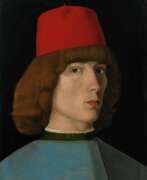

Jacopo da Valenza was an Italian Renaissance painter.
He worked between 1485 and 1509 in many churches in the Belluno and Vittoria districts of Veneto, creating altarpieces and altarpieces. Two of his most important works are now preserved in Vittorio Veneto, in their original locations: the Madonna and Child on the Throne in the cathedral of Ceneda, 1484, and the Madonna and Child in the church of San Giovanni Battista di Serravalle, 1502. Some works are in museums in Italy.
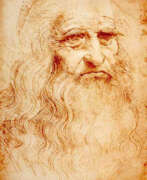

Leonardo da Vinci was an Italian polymath of the High Renaissance, celebrated as a painter, draughtsman, engineer, scientist, theorist, sculptor, and architect. His remarkable abilities and innovative thinking made him an epitome of the Renaissance humanist ideal. Born in Vinci, near Florence, in 1452, Leonardo was educated in Florence by Andrea del Verrocchio, a renowned painter and sculptor. He began his career in Florence, later working in Milan, Rome, and France, where he died in 1519.
Da Vinci is revered for his artistic mastery, technological innovation, and scientific inquiry. Despite having fewer than 25 major works attributed to him, including several unfinished ones, his influence on Western art is profound. His magnum opus, the "Mona Lisa," housed in the Louvre Museum, Paris, is considered the world's most famous painting. "The Last Supper," his most reproduced religious painting, showcases his mastery of dramatic narrative and pictorial illusionism. Both paintings exhibit Leonardo's unique ability to convey complex human emotions and his innovative use of techniques like sfumato and chiaroscuro.
Leonardo's interests extended far beyond fine art. He was a visionary in multiple fields, including anatomy, physics, architecture, and mechanics. His notebooks reveal designs for machines like bicycles, helicopters, and military tanks, centuries ahead of their time. However, due to his diverse interests, he left many projects and paintings incomplete. Leonardo's final years were spent in France, where he continued his artistic and scientific pursuits until his death.
For collectors and experts in art and antiques, Leonardo da Vinci remains a figure of endless fascination. His works not only embody the pinnacle of Renaissance art but also provide insights into the era's scientific and philosophical inquiry. To stay updated on new sales and auction events related to Leonardo da Vinci, sign up for our newsletter. This subscription is a gateway to exploring the rich legacy of this unparalleled artist and inventor.
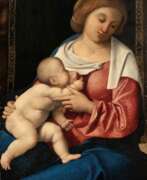

Vincenzo dalle Destre or Vincenzo dai Destri was an Italian painter who worked in Treviso and Venice from 1488.
In 1530 Destre was included among the members of the brotherhood of painters of Venice. He painted altars and churches with scenes from the Bible, and his skill was highly valued by his contemporaries.
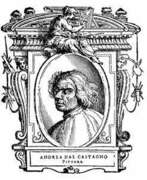

Andrea del Castagno was an illustrious Italian Renaissance painter, celebrated for his pioneering role in the evolution of art during the 15th century. Born around 1419 near Florence, Italy, Castagno's work is synonymous with the emotional power and naturalistic treatment of figures, a testament to his innovative approach that diverged significantly from the prevailing artistic norms of his time. His ability to imbue frescoes and paintings with a sense of depth, character, and realism marked a departure from the less detailed and more symbolic art of the earlier Middle Ages, aligning him with the burgeoning humanist ideals of the Renaissance.
One of Castagno's most revered works, "The Last Supper," executed in the refectory of the convent of Sant'Apollonia in Florence, showcases his mastery in creating lifelike figures and spatial depth. This particular fresco was notable for its unprecedented detail and naturalism, setting a precedent that would later influence Leonardo da Vinci's rendition of the same subject. Besides "The Last Supper," Castagno's contributions include a series of portraits of famous men for the Villa Carducci at Legnaia and significant religious works such as the "Assumption with Saints Julian and Miniato," now housed in Berlin. His work in Venice, particularly the frescoes in the San Zaccaria church, further exemplifies his innovative use of perspective and his influence from contemporaries like Donatello and Paolo Uccello.
Despite his relatively short life, succumbing to the plague in 1457, Castagno's legacy is profound, impacting not just his contemporaries but also setting a foundation for future generations. His works reside in prestigious galleries worldwide, serving as a beacon of the Renaissance's artistic achievements and the enduring appeal of realistic, emotionally resonant art.
For art collectors and experts, understanding Castagno's contributions offers invaluable insights into the evolution of Renaissance art and its foundational impact on Western artistic traditions. His works not only reflect the technological and philosophical advancements of the time but also highlight the individual artist's role in societal shifts.
To stay informed on the latest sales and auction events related to Andrea del Castagno's works, signing up for updates is advisable. This ensures exclusive access to invaluable opportunities to acquire pieces by one of the Renaissance's pivotal figures, enriching collections with historical and artistic significance.
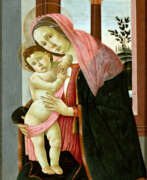

Jacopo del Sellaio was an Italian painter of the early Renaissance, active in his native Florence. His real name was Jacopo di Arcangelo. He worked in an eclectic style based on those of Botticelli, Filippino Lippi, and Domenico Ghirlandaio. The nickname Sellaio derives from the profession of his father, a saddle maker.
Today Sellaio is best known for paintings from the fronts of cassoni, or wedding chests. These often depict stories from ancient mythology, Roman history, or the Bible.
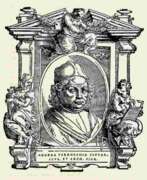

Andrea del Verrocchio, a prominent figure of the Italian Renaissance, was a master of multiple disciplines including sculpture, painting, and goldsmithing. Born in Florence around 1435, Verrocchio was a versatile artist whose influence extended far beyond his own creations, most notably as the mentor to Leonardo da Vinci. His works span a range of media, showcasing his expertise in both the sculptural and painterly aspects of Renaissance art.
Verrocchio's studio was a fertile ground for the incubation of Renaissance artistic talent. Among his most celebrated works is the bronze statue of David, commissioned by the Medici, which displays a youthful victor standing over Goliath, emblematic of Florence's civic pride and cultural ambition. This piece, alongside his equestrian statue of Bartolomeo Colleoni in Venice, exemplifies Verrocchio's skill in capturing dynamic figures and his innovative approach to bronze casting.
In painting, Verrocchio's contributions, though fewer in number, are significant for their exploration of depth and perspective, hallmarks of Renaissance artistry. His Baptism of Christ, for example, is notable not only for its own merits but also for Leonardo da Vinci's participation, which, according to legend, led Verrocchio to never paint again, outshone by his pupil's talent. However, this story is often considered apocryphal.
Verrocchio's legacy is cemented by the breadth of his work and the generations of artists he influenced. His adeptness across multiple forms—sculpture, painting, and goldsmithing—places him among the Renaissance's most versatile and influential figures. His sculptures and paintings remain pivotal in understanding the evolution of Renaissance art, characterized by a deep understanding of human anatomy, a mastery over materials, and an innovative approach to traditional themes.
For collectors and experts in art and antiques, Verrocchio's works offer a fascinating insight into the mastery and creativity of the Renaissance period. His influence on subsequent generations of artists underscores the enduring value and appeal of his creations.
For those interested in staying informed about upcoming sales and auction events featuring works by Andrea del Verrocchio, signing up for updates can provide exclusive access to the latest offerings in this realm. This ensures that enthusiasts and collectors alike remain connected to the vibrant market for Renaissance art, celebrating the legacy of one of its most distinguished masters.
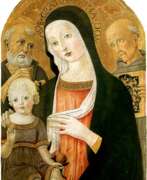

Benvenuto di Giovanni di Meo del Guasta, an Italian painter hailing from Siena, was recognized for his compelling panel paintings, frescoes, and manuscripts produced over a span of 43 years, during the Renaissance period. Born around 1436, his work life was largely based in Siena, where he was first documented as a young artist in 1453. His teacher was likely Vecchietta, with whom he collaborated on fresco decoration in Siena's baptistry. Di Giovanni married Jacopa di Tommaso da Cetona in 1466, which marked the beginning of a productive period that saw the creation of notable works such as the Annunciation and Saints (1466) and the Nativity (1470).
Benvenuto di Giovanni's style was characterized by its noble, classical forms and bright, intensely lit, glassy consistency, influenced by his interaction with North Italian miniaturists like Liberale da Verona and Girolamo da Cremona. His works, such as the triptych from Montepertuso (1475), the Borghesi altarpiece, and the triptych in the National Gallery, London (1479), stand as masterpieces of his sharply defined and surreal world. In the later years of his career, di Giovanni was commissioned for floor designs in the Siena cathedral and miniatures for its choir books, showing a style that occasionally simplified due to collaboration with his son, Girolamo di Benvenuto, but remained distinctively his.
Significant works by Benvenuto di Giovanni include "The Adoration of the Magi" and "The Crucifixion," both showcasing his mastery in perspective and religious narrative. For collectors and experts in art and antiques interested in the evocative and historically rich works of the Renaissance, Benvenuto di Giovanni's oeuvre offers a captivating exploration of 15th-century Sienese artistry.
To stay updated on sales and auction events featuring works by Benvenuto di Giovanni, sign up for updates. This subscription ensures that enthusiasts and collectors are always informed about new opportunities to engage with the exquisite works of this renowned Renaissance artist.
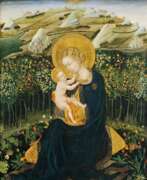

Giovanni di Paolo di Grazia was an Italian painter, working primarily in Siena, becoming a prolific painter and illustrator of manuscripts, including Dante's texts. He was one of the most important painters of the 15th century Sienese School. His early works show the influence of earlier Sienese masters, but his later style was more individual, characterized by cold, harsh colours and elongated forms. His style also took on the influence of International Gothic artists such as Gentile da Fabriano. Many of his works have an unusual dreamlike atmosphere, such as the surrealistic Miracle of St. Nicholas of Tolentino painted about 1455 and now housed in the Philadelphia Museum of Art, while his last works, particularly Last Judgment, Heaven, and Hell from about 1465 and Assumption painted in 1475, both at Pinacoteca Nazionale (Siena), are grotesque treatments of their lofty subjects. Giovanni's reputation declined after his death but was revived in the 20th century.
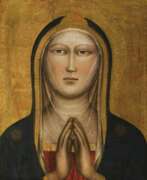

Niccolò di Pietro Gerini was a pivotal figure in the Italian art scene of the late Gothic period, celebrated for his contributions that spanned from the late 14th to the early 15th century. Born in Florence around 1340, Gerini's artistry flourished within the walls of his native city, although his talent also led him to work in Pisa and Prato. Unlike the innovative currents that swept through the art world during his time, Gerini remained faithful to traditional compositions, favoring stiff and dramatic movements in his figures.
Gerini's education and career were deeply intertwined with the artistic guilds of Florence. His father's membership in the Guild of Saint Luke in 1339 paved the way for Gerini's own entry into the Arte dei Medici e Speziali Guild by 1368, a testament to his early involvement in the city's artistic fabric. His works, marked by their large chins, sloping foreheads, and sharp noses, bore the influence of Gothic depictions, aligning him with the schools of Giotto di Bondone, Andrea di Orcagna, and Taddeo Gaddi.
Throughout his career, Gerini collaborated with notable artists like Jacopo di Cione, contributing to frescoes for the Guild hall of the Judges and Notaries in Florence and working on significant projects such as the altarpiece for the Coronation of the Virgin at San Pier Maggiore, Florence. His ability to blend architectural design with his painting skill is evident in these collaborations.
Gerini's paintings, including the triptych from 1387 housed in the National Gallery, London, and the Crucifixion, showcase his mastery over egg tempera on wood, a medium through which he conveyed religious narratives with profound solemnity and intricate detail. His works are preserved in prestigious collections, including The Hermitage, St. Petersburg, and the Alte Pinakothek, Munich, reflecting his enduring legacy in the annals of art history.
For collectors and experts in art and antiques, Gerini's oeuvre offers a rich exploration of late Gothic artistry, characterized by its adherence to traditional values while simultaneously capturing the spiritual and cultural nuances of his time. To stay informed on new discoveries and auction events related to Niccolò di Pietro Gerini, signing up for updates is a valuable resource for enthusiasts keen on this remarkable period of art history.
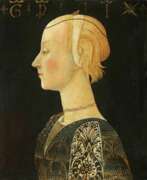

Giovanni di Ser Giovanni Guidi, more famously known as Scheggia, was an Italian painter whose contributions to the arts during the Renaissance period have carved him a distinct niche in art history. Born in Italy, Scheggia was a craftsman of narrative and decorative painting, specializing in altarpieces, cassone panels, and birth trays, which were popular in Florentine culture for their intricate storytelling and detailed artistry.
Scheggia is perhaps best known for his lively and detailed panels that graced the fronts of marriage chests, known as cassoni. These pieces were celebrated for their vivid depictions of allegorical and mythological scenes, showcasing Scheggia's skillful use of color and composition to bring tales to life. His work not only adorned the homes of the wealthy but also served as a testament to the rich cultural and artistic fervor of Renaissance Florence.
One of Scheggia's most notable works, the "Madonna of Humility with Angels," showcases his ability to blend divine and earthly realms in a harmonious composition that speaks volumes of his mastery over form and space. This, among other works by Scheggia, can be admired in museums across Italy, offering a glimpse into the vibrant Renaissance art scene.
For collectors and experts in art and antiques, Giovanni di Ser Giovanni Guidi represents an intriguing exploration into the less-trodden paths of Renaissance art. His paintings are a celebration of the era's innovative spirit, offering insights into the everyday lives, cultural practices, and artistic achievements of the time.
To delve deeper into the world of Renaissance art and uncover the gems of Giovanni di Ser Giovanni Guidi's legacy, signing up for updates is an essential step. This subscription ensures that enthusiasts and collectors are the first to know about new discoveries, exhibitions, and auction events related to Scheggia's work, providing exclusive opportunities to enrich their appreciation and collections of Renaissance art.
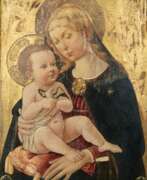

Domenico di Zanobi, formerly known as the Master of the Johnson Nativity, was an Italian Renaissance painter. His exact dates of birth and death are not known. He is documented as a mature artist from 1467 until 1481.
Since none of his paintings are signed, historian Everett Fahy named their artist the "Master of the Johnson Nativity," after the panel of the Nativity in the Johnson Collection at the Philadelphia Museum of Art.
He painted primarily religious subjects, including altarpieces and many small panels for private devotion.
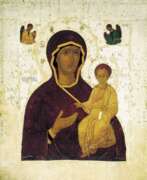

Dionisius, a distinguished Russian icon painter born around 1440, emerged as a pivotal figure in the Moscow school of icon painters, particularly towards the late 15th and early 16th centuries. His work is characterized by a unique style known as Muscovite mannerism, which features elongated figures, diminutive hands and feet, and serene, peaceful faces. Dionisius's artistry is most notably encapsulated in his comprehensive and best-preserved work, the fresco painting of the Virgin Nativity Cathedral at the Ferapontov Monastery, which stands out for its singularly pure and gentle colors, imbuing the scenes from the life of the Virgin with a solemn and festal mood.
Throughout his career, Dionisius enjoyed the patronage of many rich and notable figures, including Joseph of Volokolamsk, who commissioned him to paint over eighty icons for various cloisters. His first significant commission was for the Cathedral of the Dormition in the Moscow Kremlin in 1481. His Crucifixion icon, created in 1500, is particularly revered and showcases a novel approach to depicting this key scene in the Christian tradition, focusing on Jesus Christ, the Blessed Virgin Mary, and John the Theologian with an emphasis on suffering and redemption.
Dionisius's legacy extends beyond his own works to include several iconic panels attributed to him, showcasing various religious figures and scenes that profoundly influenced Russian art and iconography in the centuries that followed. His depictions often featured innovative elements, such as the personified Church and Synagogue, underscoring his significant impact on the development of Russian Orthodox art.
For collectors and experts in art and antiques, Dionisius's work represents a quintessential chapter in the history of Russian iconography, offering a deep well of cultural, historical, and artistic significance. To stay informed about new discoveries and auction events related to Dionisius's work, signing up for updates can offer valuable insights and opportunities to engage with this remarkable aspect of Russian heritage.
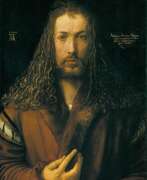

Albrecht Dürer, born on May 21, 1471 in Nuremberg, Germany, is widely regarded as the greatest German Renaissance painter. His contribution to painting and engraving is quite significant and has left a notable mark on the art world. Dürer's early life was spent in Nuremberg, a city that played a crucial role in his development as an artist and was also the site of his death on April 6, 1528. He was the son of the goldsmith Albrecht Dürer the Elder, from whom he initially learned the basics of drawing and metalworking.
Dürer's work is characterized by a combination of Gothic elements with the emerging Renaissance style, which is evident in his woodcuts and engravings. His oeuvre encompasses many themes, including religious works, altarpieces, portraits, and self-portraits. His outstanding prints, such as The Knight, Death and the Devil (1513), St. Jerome in his Study (1514) and Melencolia I (1514), are known for their intricate detail and artistic skill. Dürer was also one of the earliest European landscape painters, as evidenced by his watercolor paintings.
Equally significant are his theoretical writings on mathematics, perspective, and ideal proportions in art. Dürer was not only an artist but also a keen intellectual, his interests encompassing various aspects of culture and science. He served as court painter to Holy Roman Emperors Maximilian I and Charles V, completing several significant art projects for them. Dürer's keen mind and versatile interests brought him into contact with the most prominent figures of his time, including theologians and scientists of the Reformation era.
Dürer's self-portraits are particularly famous, demonstrating not only his artistic skill but also his self-awareness and personal style. These portraits attest to his growing success and confidence as an artist. Dürer's legacy is immense; he influenced not only the art of his time, but also left an indelible mark on the history of European art.
For those interested in the work and legacy of Albrecht Dürer, we recommend subscribing to our updates. Our subscription service is designed to provide information about new sales and auction events related to this remarkable artist. Join us to keep up to date on the latest art and antiques related to Albrecht Dürer.
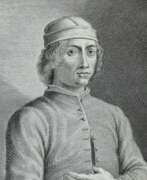

Francesco Francia, also known as Francesco Raibolini, was an Italian painter, goldsmith, and medallist from Bologna. He began his career in the late 15th century and collaborated with artists like Lorenzo Costa, drawing inspiration from the styles of Ercole de' Roberti, Perugino, and Raphael.
Francia ran a successful workshop and trained notable artists such as Marcantonio Raimondi and Ludovico Marmitta. While it was once rumored that Raphael's work caused him to die of depression, their friendship has since debunked this claim.
Francesco Francia passed away in Bologna, and his sons, Giacomo Francia and Giulio Francia, also became artists.
